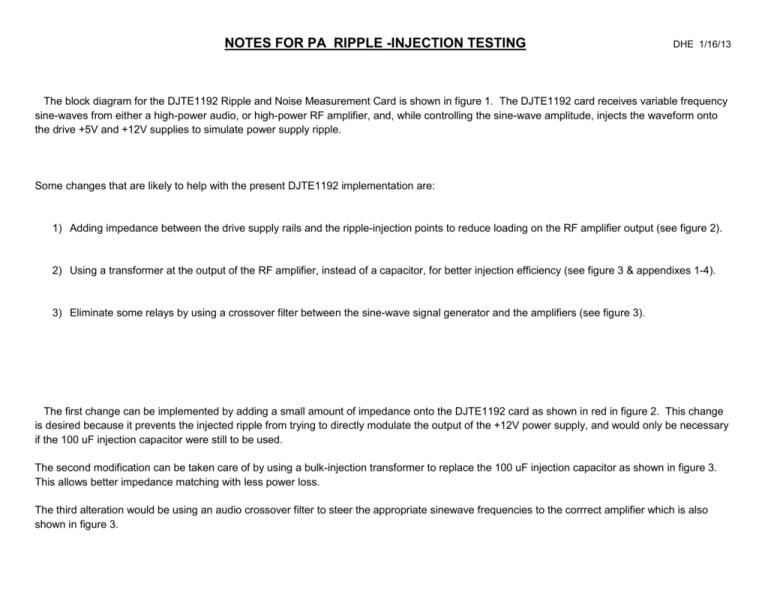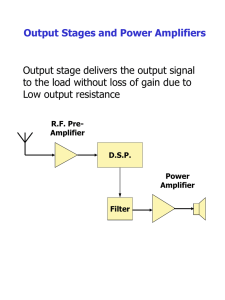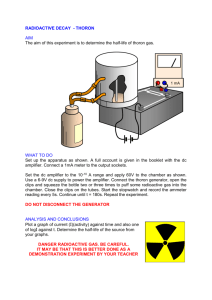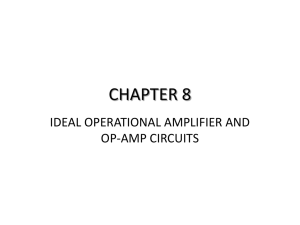Ripple Injection Info
advertisement

NOTES FOR PA RIPPLE -INJECTION TESTING DHE 1/16/13 The block diagram for the DJTE1192 Ripple and Noise Measurement Card is shown in figure 1. The DJTE1192 card receives variable frequency sine-waves from either a high-power audio, or high-power RF amplifier, and, while controlling the sine-wave amplitude, injects the waveform onto the drive +5V and +12V supplies to simulate power supply ripple. Some changes that are likely to help with the present DJTE1192 implementation are: 1) Adding impedance between the drive supply rails and the ripple-injection points to reduce loading on the RF amplifier output (see figure 2). 2) Using a transformer at the output of the RF amplifier, instead of a capacitor, for better injection efficiency (see figure 3 & appendixes 1-4). 3) Eliminate some relays by using a crossover filter between the sine-wave signal generator and the amplifiers (see figure 3). The first change can be implemented by adding a small amount of impedance onto the DJTE1192 card as shown in red in figure 2. This change is desired because it prevents the injected ripple from trying to directly modulate the output of the +12V power supply, and would only be necessary if the 100 uF injection capacitor were still to be used. The second modification can be taken care of by using a bulk-injection transformer to replace the 100 uF injection capacitor as shown in figure 3. This allows better impedance matching with less power loss. The third alteration would be using an audio crossover filter to steer the appropriate sinewave frequencies to the corrrect amplifier which is also shown in figure 3. DJTE1192 Ripple & Noise Measurement Card Block Diagram N-FET +12 V 5 8 RTE24012 1000 uF NC 6 4 +12V to Drive NC 7 PC/HBA Interface 9 Port A External Power Supply Drive Port B 5 NC 6 PC Interface GPIB/Serial 13 4 +5V to Drive NC 7 11 9 14 Audio Transformer 8 NC 3 5 4 8 PC Interface GPIB/Serial 8 RTE24012 1000 uF 6 5 ARE1312 N-FET +5 V Oscilloscope 11 14 8 100 uF ARE1312 RTE24012 NC NC 9 NC 7 4 6 5 Hz to 20 KHz Audio Amplifier (constant gain) PC Interface GPIB/Serial PC Interface GPIB/Serial 11 10 KHz to 100 MHz RF Amplifier (constant gain) Function Generator Figure 1 DJTE1192 Ripple & Noise Measurement Card Block Diagram with added impedance N-FET +12 V 5 8 RTE24012 1000 uF NC 6 4 +12V to Drive NC 7 PC/HBA Interface 9 Port A External Power Supply Drive Port B z N-FET +5 V 5 8 RTE24012 1000 uF NC 6 4 +5V to Drive NC 7 9 z 13 11 14 Audio Transformer NC 3 5 4 8 PC Interface GPIB/Serial 8 6 5 ARE1312 PC Interface GPIB/Serial Oscilloscope 11 14 8 100 uF ARE1312 RTE24012 NC NC 9 NC 7 4 6 5 Hz to 20 KHz Audio Amplifier (constant gain) PC Interface GPIB/Serial PC Interface GPIB/Serial 11 10 KHz to 100 MHz RF Amplifier (constant gain) Function Generator Figure 2 Suggested Modifications for DJTE1192 Ripple & Noise Measurement Card N-FET +12 V 5 8 RTE24012 1000 uF NC 6 4 +12V to Drive NC 7 PC/HBA Interface 9 Port A External Power Supply Drive Port B N-FET +5 V 5 8 RTE24012 1000 uF NC 6 4 +5V to Drive NC 7 9 PC Interface GPIB/Serial Audio Transformer Bulk Injection Transformer PC Interface GPIB/Serial Low Pass Filter 15KHz Electronic Crossover 5 Hz to 20 KHz Audio Amplifier (constant gain) PC Interface GPIB/Serial High Pass Filter Oscilloscope PC Interface GPIB/Serial 10 KHz to 100 MHz RF Amplifier (constant gain) Function Generator Figure 3 Appendix 1 Peak current occurring when a capacitors voltage is changing sinusoidally For a sine wave of frequency 𝒇, and peak voltage 𝑽𝒑𝒆𝒂𝒌, the fastest slew rate occurs when the sine wave voltage 𝑽 = 𝑽𝒑𝒆𝒂𝒌 ∗ 𝒔𝒊𝒏(𝟐 ∗ 𝝅 ∗ 𝒇 ∗ 𝒕) crosses zero at 𝒕 = 𝟎 (see figure 4). Max dv/dt Figure 4 The maximum slew rate of the sine wave can be found by first taking the derivative of the sine wave voltage with respect to time 𝒕: 𝒅𝑽/𝒅𝒕 = 𝒅( 𝑽𝒑𝒆𝒂𝒌 ∗ 𝒔𝒊𝒏(𝟐 ∗ 𝝅 ∗ 𝒇 ∗ 𝒕) )/𝒅𝒕 = (𝑽𝒑𝒆𝒂𝒌 ∗ 𝟐 ∗ 𝝅 ∗ 𝒇) ∗ 𝒄𝒐𝒔(𝟐 ∗ 𝝅 ∗ 𝒇 ∗ 𝒕) Appendix 1 (cont.) Then, setting the value of 𝒕 in the cosine term to zero, we get: 𝑴𝒂𝒙 𝒅𝑽/𝒅𝒕 = (𝑽𝒑𝒆𝒂𝒌 ∗ 𝟐 ∗ 𝝅 ∗ 𝒇) ∗ 𝒄𝒐𝒔(𝟎) = (𝑽𝒑𝒆𝒂𝒌 ∗ 𝟐 ∗ 𝝅 ∗ 𝒇) ∗ 𝟏 = (𝑽𝒑𝒆𝒂𝒌 ∗ 𝟐 ∗ 𝝅 ∗ 𝒇) = 𝑽𝒑𝒆𝒂𝒌−𝒑𝒆𝒂𝒌 ∗ 𝝅 ∗ 𝒇 where 𝑽𝒑𝒆𝒂𝒌−𝒑𝒆𝒂𝒌 = 𝑽𝒑𝒆𝒂𝒌 ∗ 𝟐 The current required to change the voltage across a capacitor is proportional to the rate-of-change in the capacitors voltage, and is expressed as: 𝑰 = 𝑪(𝒅𝑽/𝒅𝒕) where 𝑪 is the capacitance and 𝑽 is the voltage The maximum or peak current occurring when a capacitors voltage is changing sinusoidally, therefore, can be written as: 𝑰𝒑𝒆𝒂𝒌 = 𝑪(𝑴𝒂𝒙 𝒅𝑽/𝒅𝒕) = 𝑪 ∗ 𝑽𝒑𝒆𝒂𝒌−𝒑𝒆𝒂𝒌 ∗ 𝝅 ∗ 𝒇 Appendix 2 Peak current available from an AR 75A250 RF amplifier (typically used in Product Assurance) Similar to the peak current equation in appendix 1, for an amplifier driving a capacitive load, the peak amplifier current is (see fig. 5): 𝑰𝒑𝒆𝒂𝒌 = (𝑪𝒍𝒐𝒂𝒅 + 𝑿𝒑𝑭 )(𝑴𝒂𝒙 𝒅𝑽/𝒅𝒕) = (𝑪𝒍𝒐𝒂𝒅 + 𝑿𝒑𝑭 ) ∗ 𝑽𝒑𝒆𝒂𝒌−𝒑𝒆𝒂𝒌 ∗ 𝝅 ∗ 𝒇 Driving Capacitive Loads with Sine waves I = (CLOAD + XPF) * VPEAK-PEAK * π * f Where: VPEAK-PEAK I = the peak current needed from the amplifier CLOAD = the load capacitance XPF = the internal output capacitance of the amplifier in picofarads VPEAK -PEAK = the peak-to-peak voltage applied to the capacitive load π = 3.14 Figure 5 f = the maximum output frequency Appendix 2 (cont.) The peak output current from an Amplifier Research model 75A250 RF amplifier may not be listed in its datasheet, but it can be calculated from the amplifiers output wattage rating and output impedance. Using the 75A250 minimum output power rating of 75 Watts CW (continuous wave, i. e., average power), and its output impedance specification of 50 Ohms, and assuming the amplifier load impedance is also 50 Ohms, we can write: 𝑾𝒂𝒕𝒕𝒔 = 𝑽𝒐𝒍𝒕𝒔 ∗ 𝑨𝒎𝒑𝒔 = 𝑽 ∗ 𝑰 = (𝑰 ∗ 𝑹) ∗ 𝑰 = 𝑰𝟐 ∗ 𝑹 ⇒ 𝑰𝟐 = 𝑾𝒂𝒕𝒕𝒔/𝑹 ⇒ 𝑰 = √𝑾𝒂𝒕𝒕𝒔/𝑹 ⇒ 𝑰𝒓𝒎𝒔 = √𝑾𝒂𝒕𝒕𝒔𝒂𝒗𝒈 /𝑹 The current available from a 75W amplifier with a 50 Ohm output impedance and a 50 Ohm load is, therefore: 𝑰𝒓𝒎𝒔 = √𝟕𝟓 𝑾𝒂𝒗𝒈 / 𝟓𝟎 𝜴 = 𝟏. 𝟐𝟐 𝑨𝒓𝒎𝒔 Similarly, the voltage available is: 𝑽𝒓𝒎𝒔 = √𝟕𝟓 𝑾𝒂𝒗𝒈 ∗ 𝟓𝟎 𝜴 = 𝟔𝟏. 𝟐𝟒 𝑽𝒓𝒎𝒔 And as a check on the calculations: 𝑽𝒓𝒎𝒔 / 𝑰𝒓𝒎𝒔 = 𝟔𝟏. 𝟐𝟒 𝑽𝒓𝒎𝒔 / 𝟏. 𝟐𝟐 𝑨𝒓𝒎𝒔 = 𝟓𝟎𝜴 The peak current can be calculated from the RMS current as: 𝑰𝒑𝒆𝒂𝒌 = 𝑰𝒓𝒎𝒔 ∗ √𝟐 = 𝟏. 𝟐𝟐 𝑨𝒓𝒎𝒔 ∗ 𝟏. 𝟒𝟏𝟒 = 𝟏. 𝟕𝟐𝟓 𝑨𝒑𝒆𝒂𝒌 NOTE: Since it is not necessarily guaranteed for an AR 75A250 amplifier to provide peak current for a useful amount of time, we could be conservative and pick the RMS current value of 1.22 A as the true amplifier output current, but for the sake of argument, we’ll just use the 1.725 A peak current value. Appendix 3 The maximum frequency at which an AR 75A250 RF amplifier can deliver peak current into a capacitive load Since the peak current for a sinusoidal capacitor voltage can be found from (see appendix 1): 𝑰𝒑𝒆𝒂𝒌 = 𝑪 ∗ 𝑽𝒑𝒆𝒂𝒌−𝒑𝒆𝒂𝒌 ∗ 𝝅 ∗ 𝒇 Then, using 𝑰𝒑𝒆𝒂𝒌 = 𝟏. 𝟕𝟐𝟓𝑨 from appendix 2, the maximum frequency at which the Amplifier Research model 75A250 amplifier can provide 20 mV of ripple on a supply rail with a minimum of 33 uF of capacitance can be calculated as: 𝒇 = 𝑰𝒑𝒆𝒂𝒌 / (𝑪 ∗ 𝑽𝒑𝒆𝒂𝒌−𝒑𝒆𝒂𝒌 ∗ 𝝅) = 𝟏. 𝟕𝟐𝟓 𝑨 / (𝟑𝟑 𝒖𝑭 ∗ 𝟐𝟎 𝒎𝑽 ∗ 𝟑. 𝟏𝟒𝟏𝟔) = 𝟖𝟑𝟏. 𝟗 𝑲𝑯𝒛 Appendix 4 Efficiency of using an AR 75A250 RF amplifier with capacitive coupling for the ripple injection AR 75A250 Amplifier 831.9 KHz 831.9 KHz 50 Ω 100 uF of Injection Capacitance 33 uF of Drive Bulk Capacitance Figure 6 If sinusoidal ripple is injected onto a drive +12V supply voltage using a 100 uF capacitor connected to the 50Ω output of an AR 75A250 Amplifier (as in figure 6 above), and the bulk capacitance of the +12V supply rail is 33 uF, then the 100 uF and 33 uF capacitive reactances can be calculated as follows: Appendix 4 (cont.) The reactance of the 100 uF of injection capacitance at 831.9 KHz is: Xc100 uF = 𝟏 / (𝟐 ∗ 𝝅 ∗ 𝒇 ∗ 𝑪) = 𝟏 / (𝟐 ∗ 𝟑. 𝟏𝟒𝟏𝟔 ∗ 𝟖𝟑𝟏. 𝟗 𝑲𝑯𝒛 ∗ 𝟏𝟎𝟎 𝒖𝑭) = . 𝟎𝟎𝟏𝟗 𝜴 = 𝟏. 𝟗 𝒎𝜴 The reactance of the 33 uF of bulk capacitance at 831.9 KHz is: Xc33 uF = 𝟏 / (𝟐 ∗ 𝝅 ∗ 𝒇 ∗ 𝑪) = 𝟏 / (𝟐 ∗ 𝟑. 𝟏𝟒𝟏𝟔 ∗ 𝟖𝟑𝟏. 𝟗 𝑲𝑯𝒛 ∗ 𝟑𝟑 𝒖𝑭) = . 𝟎𝟎𝟓𝟕𝟗 𝜴 = 𝟓. 𝟖 𝒎𝜴 Figure 6, then, would reduce to the impedance values of figure 7 at 831.9 KHz. For a 1Vpk-pk amplifier output at that frequency, the ripple voltage appearing across the 33 uF of filter capacitance, would, because of voltage division, be very small (as calculated below): 𝑹𝒊𝒑𝒑𝒍𝒆 𝒗𝒐𝒍𝒕𝒂𝒈𝒆 = 𝟏𝑽 ∗ (𝟓. 𝟖 𝒎𝜴/ ( 𝟓𝟎𝜴 + 𝟏. 𝟗 𝒎𝜴 + 𝟓. 𝟖 𝒎𝜴)) = 𝟏𝑽 ∗ (𝟓. 𝟖 𝒎Ω / 𝟓𝟎. 𝟎𝟎𝟕𝟕𝜴) = 𝟏𝑽 ∗ 𝟏𝟏𝟔𝑬 − 𝟎𝟔 = . 𝟏𝟏𝟔 𝒎𝒗 => . 𝟎𝟏𝟏𝟔 % 𝒆𝒇𝒇𝒊𝒄𝒊𝒆𝒏𝒄𝒚 Appendix 4 (cont.) 831.9 KHz 831.9 KHz 50 Ω 50 Ω 100 uF .0019 Ω = XC100uF 33 uF .0058 Ω = XC33uF Figure 7 A conclusion is, that when using an AR 75A250 Amplifier to inject sinusoidal ripple on the +5V or +12V supply rail of a typical drive, the frequencies at which an ideal supply rail capacitance will show any significant ripple voltage would, theoretically, be well below 1 MHz. In the real world, ripple voltage showing up on supply rails at frequencies much above 1 MHz is probably because the self-resonant frequency of the supply rail filter capacitors has been exceeded and the capacitors are now looking more inductive than capacitive at higher frequencies.








